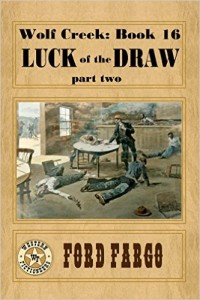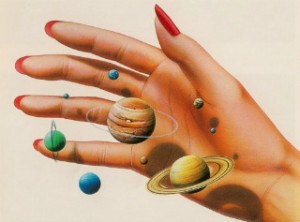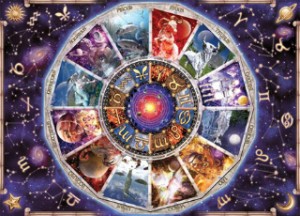I’ve been invited to create a new character for the Western Fictioneers – something for the shared world of Wolf Creek. This is an 1872 town on the Kansas prairie, with characters created by a variety of authors. We’ve just published Book 16 and my new character will make his appearance in the next anthology.
I thought I’d share a few tips on creating a new character, as I go through the process:
- Start with the basics – first, you need to decide what gender, race and age your character is going to be. This may change later, but start with the basic information in mind so you have that general image.
- Add details – decide how your character looks (at least the bare minimum of hair & eye color, approximate size, and anything unusual) and how they dress. Imagine the outer package for your character.
- Pick a setting – where does your character come from? Where do they live and work? What do they do and how well do they do it? See your character in their natural habitat before you begin your story.
- Fill out a chart (or two) – find one (or more) of those character charts … and you can’t go wrong with mine – just use the drop-down menu above, under Writer’s Toolkit! Fill out the chart(s) to learn about your character’s personality so you’ll know how they will act in your story.
- Christen your child – once you can see the character clearly in your mind, it’s time to pick a name. By this time, you’ll know the sort of name that fits the character best, whether it’s a traditional name to match their ethnicity, a nickname, or something that describes their personality. My character chart also has a few links at the bottom to help you name characters.
And that’s how I came up with my new character, who’s going to be a sort of Junior Chance – young teens, mixed race, very intelligent, and a budding criminal mastermind. He’s going to serve as a connection between the different parts of Wolf Creek, running messages and selling information, performing tasks that may not be quite legal, and generally being a go-between when a citizen doesn’t want to (or can’t afford to) be seen in a certain part of town.
(Astrology as a method of character development)
Thanks to Ken Farmer for reminding me of this trick.
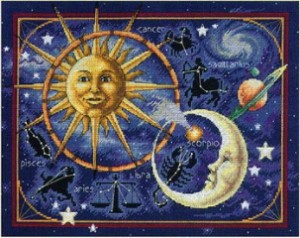 One of the things you need to know in order to develop your characters is their personality. One “quick and dirty” trick to getting a start on this is to use astrology.
One of the things you need to know in order to develop your characters is their personality. One “quick and dirty” trick to getting a start on this is to use astrology.
I’m not necessarily advocating astrology – or even stating whether or not I believe in it – but any good astrology website will give you a great little personality profile. That will give you a starting place for your character’s development.
You can go about this in two basic ways:
- Pick a random birthdate for your character and investigate the sign associated with that birthdate.
- Read through an astrology site and see if any of the personality charts sound like your character.
Let’s look at how this works.
Here’s what the website has to say about Gemini (Chance’s sign):
“A Gemini can change his clothes, his job, his love life or his residence as fast as he changes his mind, and that’s pretty fast. Finding a good example to study may keep you hopping. You could try a bookstore. He’s a browser, because he can get the gist of the contents in a brief scanning of the pages. (It’s no accident that John F. Kennedy was a speed reader.) Mercury people also have that nasty habit of reading the last page first.
When you’ve found this quicksilver person, study him carefully, even if you do get exhausted following him around. The first thing you’ll notice is a nervous energy that fairly snaps, crackles and pops in the air around him. An occasional Gemini will speak slowly, but most of them talk fast. All of them listen fast.
Man or woman, Gemini is impatient with conservative stick-in-the-muds, or with people who can’t make up their minds where they stand on particular issues. Gemini knows where he stands, at least for the moment.
Unless there’s a conflicting ascendant, the Gemini build is generally slender, agile and taller than average. Many of them have small, sharp features, as if they were cut in a cameo. You’ll find some with brown eyes, of course, but the majority of those ruled by Mercury will have beautiful, crystal-clear hazel, blue, green or gray eyes that twinkle and dart here and there. Geminis never rest their eyes on one object for more than a few seconds. In fact, their alert, quick-moving eyes are often the easiest way to recognize them. The complexion tends to be rather pale, yet they usually tan easily, and that’s the way to spot them in the summer. (In the winter, they often have wind bums from swooping down a ski slope.)
There’s an eagerness about Geminis, an immediate, sympathetic friendliness, and unusually quick, but graceful movements. The hair can be light or dark or both-like, streaked. Twins, remember? The nose is likely to be long and straight or dainty-in either case, probably well formed. There’s frequently a receding hairline in the men (from all that activity in the brain, perhaps), and both sexes normally have rather high foreheads.”
You can see that not only does a good chart give personality traits, but also some physical features. This can be quite useful for fleshing out that secondary character – or even figuring out what your main characters look like.
Try this technique the next time you’re wondering about one of your characters. I think you’ll be pleased with how much information you can get from an astrology chart.
A good panel on creating characters – here are the highlights.
Q: How do you decide on a character?
Chelsea Quin Yarbro: I let them come to me. I had one character sit in my head for ten years before I found his story.
A.J. Scudiere: I have characters and plot lines bouncing around in my head, and occasionally they stick and go together – and then I start doing my research.
Gail Z. Martin: I start with a person with a problem, then start asking “What if?” and making it worse and worse. I also ask who else surrounds my main character.
David B. Coe: There’s a synergy to building a novel – character and plot and scene come to you in different ways and tie in and feed one another. It’s a braided process.
Richard Lee Byars: I ask what kind of character would make this situation particularly good – or bad.
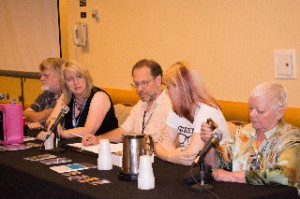
More good advice:
Gail: When you have a strong protagonist, you have to have strong, interesting secondary characters to stand up to them.
Quin; I formed a habit when I was first starting out – I create backstories for the people I see around me.
David: Writing good characters and being a good friend are very similar. You have to be able to step into their lives and understand them.
Faith Hunter: Everyone who plans to be a writer should be an analytical reader. Buy a book and a set of colored highlighter pens, and highlight examples of what you’re trying to learn. “This is a great example of dialogue,” or “This is good characterization.” I even write an index on the blank pages in the back.
Oh, and Faith came in late, so I didn’t get a good picture of her.
Once you’ve created that perfect character, you have to name him or her. This can be a challenge to many writers, especially once you’ve gotten a few hundred characters on the page. How do you come up with fresh names for all of those people? Here are some tips for you.
For Main Characters:
- Choose an ethnic background – nowadays, people just name their kids any old name without caring what the name’s history might be, but characters need to have more rationale for their names. If you want a Hispanic character to tote the name Achmed around, you’d better have a good reason for it (and make sure the readers buy into it). Check out this website for some ethnic ideas.
- Choose a name by meaning – don’t just settle for something that sounds good. Pick a name that means something appropriate to the story. It took some digging to come up with Chance Knight for my roguish “hero.” It’s worth the time to get just that right name, though. There are plenty of good baby name websites that can help you out; try this one for starters.
- Pick a sound – strong characters need strong sounds, like “K” or “P,” while softer characters need more subdued sounds. Try saying each name out loud to see if it matches your view of the character and their personality.
- Choose a nickname – does your character even have one? It’s best to go ahead and decide, then have certain people use that nickname instead of calling the character by their full name all the time.
- Pick a matching last name – again, mixing ethnicities might be all the rage today, but it might get confusing to the readers, who have been picturing Perdita as an alluring Spanish maiden, to discover that she’s actually a busty redhead from the O’Malley family. Here’s a good site with a variety of surnames to get you started.
- Choose an appropriate name – when writing a historical novel, you need to pick names that would have been common for that era. You also need to research the most popular names of each generation. If your book is set in the current day, for example, you wouldn’t be likely to find a heroine named Hester or Ethel. This is a good website for your search.
- Say the names out loud – sometimes a name that looks great on paper will provoke a laugh when pronounced, for all the wrong reasons. I’m sure you’ve met some real-life people who wished their parents had taken this step before writing their names on that birth certificate.
The Acid Test: once you have a list of possible names, find a friend who has no idea what your characters are like. Ask them to read the names and make some guesses about each character based on those. If their answers are way off base, you need to rethink the names.
Secondary Characters: if a character is important enough to merit a name, but not important enough to spend a lot of time researching, have a few good name websites bookmarked, and just pop over there to mix and match. Be sure to keep good notes, though – you don’t want a second George Rumpel showing up suddenly in a later novel, after killing him off in your first mystery.
Here are some good places I’ve searched over the years:
- Census data for a particular year and region
- Old telephone books, school yearbooks, and any other similar list of names
- Credits on movies and TV shows
- Newspapers and magazines
- Genealogy websites (if they offer free trials)
This website is another good reference to start you on the road to naming your characters.
What’s your best tip for naming characters?
Every author faces this hurdle: how to create lifelike characters who catch the reader’s interest. Here are a few tricks and tips you might be able to use:
- Pay attention! Great characters are great because they’re people you recognize. Great writers are the nosiest people you’ll ever meet, forever watching and listening to what other people are doing and saying. And it all goes into the story.
- Use your contacts. Characters are people too, and they’re going to act and speak like people you know. Model your favorite characters after your friends or enemies, your family and neighbors. Just change the names before you publish!
- Avoid Mary Sue (and Marty Stu)! People have faults. Nobody is super-special, and real people can’t bend the natural laws. Keep your characters realistic for your universe, and avoid the dreaded Mary Sue or her male counterpart. (If you’re one of the few people who has no idea what I’m talking about, just use your search engine and you’ll find more than you ever wanted to know)
- Torture them. Great characters have great conflicts. Keep your character from getting complacent (and boring) by giving them some sort of conflict to keep the tension ramped up in the story. This can be external (like an enemy or job stress) or internal (like low self-esteem or worries), but you need to give them something to make them more interesting.
- Pay attention again! Keep a character notebook and actually write down all those great conversations you “overhear” (while eavesdropping), all those interesting people you spot, and all those ideas that pop up while you’re out nosing around.
How do you come up with character ideas? Do you invent your characters first, or your plot?
